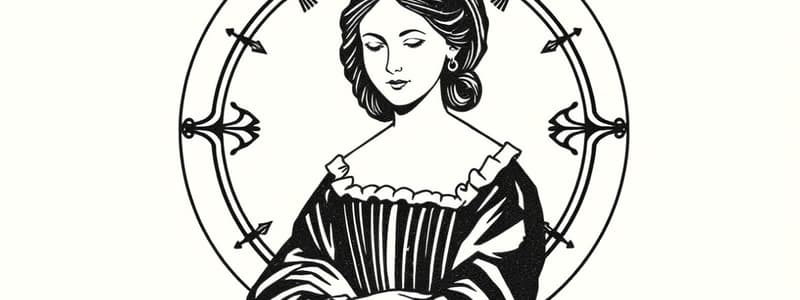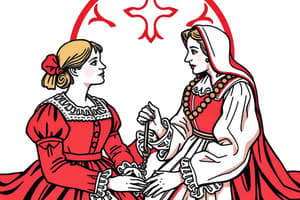Podcast
Questions and Answers
What had been Hester's teachers?
What had been Hester's teachers?
Stern and wild ones.
What does The Scarlet Letter symbolize in Chapter 18?
What does The Scarlet Letter symbolize in Chapter 18?
Individuality experiences the freedom of the mind.
What is described as a sin of passion?
What is described as a sin of passion?
Hester and Dimmesdale's sin.
What does Hester say to Dimmesdale in Chapter 17?
What does Hester say to Dimmesdale in Chapter 17?
What does Dimmesdale ask of Hester?
What does Dimmesdale ask of Hester?
What does Hester feel in the moment with Dimmesdale?
What does Hester feel in the moment with Dimmesdale?
What does the wild rosebush symbolize in 'The Scarlet Letter'?
What does the wild rosebush symbolize in 'The Scarlet Letter'?
Who suggested that Hester Prynne should have been branded with a hot iron?
Who suggested that Hester Prynne should have been branded with a hot iron?
What does 'The Scarlet Letter' represent about Hester's spirit and artistry?
What does 'The Scarlet Letter' represent about Hester's spirit and artistry?
Chillingworth's abilities include observing the human soul.
Chillingworth's abilities include observing the human soul.
What does Hester claim about her child's father?
What does Hester claim about her child's father?
Hester feels her secret of the affair with Dimmesdale slipping out, like a serpent from its ___ .
Hester feels her secret of the affair with Dimmesdale slipping out, like a serpent from its ___ .
What does Hester name her child?
What does Hester name her child?
The governor's mansion reflects the humility of the Puritans.
The governor's mansion reflects the humility of the Puritans.
What does Dimmesdale's health condition partly result from?
What does Dimmesdale's health condition partly result from?
What does Hester caution Pearl about finding joy?
What does Hester caution Pearl about finding joy?
What do the Puritan men lack in judging Hester's heart?
What do the Puritan men lack in judging Hester's heart?
What does the fire in Chillingworth's laboratory symbolize?
What does the fire in Chillingworth's laboratory symbolize?
What is Chillingworth trying to discover about Dimmesdale?
What is Chillingworth trying to discover about Dimmesdale?
Dimmesdale recognizes Chillingworth as his enemy.
Dimmesdale recognizes Chillingworth as his enemy.
Pearl warns her mother to come away from the old ______.
Pearl warns her mother to come away from the old ______.
What does Dimmesdale believe about his connection to God?
What does Dimmesdale believe about his connection to God?
Dimmesdale feels no revulsion towards Chillingworth.
Dimmesdale feels no revulsion towards Chillingworth.
What does Dimmesdale struggle with regarding his guilt?
What does Dimmesdale struggle with regarding his guilt?
What does Pearl ask Hester about the scarlet letter?
What does Pearl ask Hester about the scarlet letter?
Hester believes the scarlet letter had not done its ______.
Hester believes the scarlet letter had not done its ______.
What does Chillingworth claim is his greatest act of revenge?
What does Chillingworth claim is his greatest act of revenge?
Hester feels powerless against Chillingworth's manipulations.
Hester feels powerless against Chillingworth's manipulations.
What does Dimmesdale wish for regarding his public self?
What does Dimmesdale wish for regarding his public self?
What does the phrase 'black flower' symbolize?
What does the phrase 'black flower' symbolize?
Flashcards are hidden until you start studying
Study Notes
Setting and Symbolism
- The prison is described as an "ugly edifice" surrounded by overgrown vegetation, symbolizing the harsh realities of Puritan society.
- A wild rosebush near the prison represents compassion and beauty amidst suffering, offering a glimpse of nature's kindness to offenders.
Hester Prynne's Punishment and Character
- Hester faces extreme judgment from Puritan women, reflecting their unforgiving nature.
- The Scarlet Letter, which Hester wears, highlights her artistry and inner strength, contrasting her shame with a symbol of individuality.
- Hester's attire reflects her emotional turmoil, demonstrating her rejection of societal norms.
Themes of Suffering and Guilt
- Puritan beliefs suggest that suffering is beneficial for the soul, indicating the community's harsh views on sin.
- Chillingworth’s penetrating gaze symbolizes his role as an observer and his intent to uncover Dimmesdale's secrets.
- Hester experiences intense shame on the scaffold, acknowledging her public humiliation and internal struggle.
Chillingworth's Characterization
- Chillingworth's transformation into a menacing figure parallels his growing malice, akin to a serpent in Christian symbolism.
- He recognizes his own shortcomings, admitting he was too old and crippled to keep Hester's affection.
- His possessiveness over Hester emphasizes themes of ownership and jealousy in their relationship.
Pearl as a Symbol
- Pearl embodies Hester's sin and societal judgment; she is described as both a treasure and a source of anguish.
- Hester’s training of Pearl reflects her dual role as both a mother and a cautionary symbol for societal norms.
The Nature of Sin and Judgment
- Puritan men lack understanding of women's motivations, as shown through their rigid judgments of Hester.
- Dimmesdale struggles with his secret guilt, which manifests in his deteriorating health and emotional disconnect from others.
- Hester claims that her experiences and mistakes will ultimately impart wisdom to Pearl, suggesting a complex understanding of sin and redemption.
Social Hypocrisy
- The contrast between the opulent lifestyles of Puritan leaders and their condemnations of sin reveals societal hypocrisy.
- Hester's needlework is utilized by Governor Bellingham, demonstrating the exploitation of her skills even while she is publicly shamed.
Dimmesdale's Internal Conflict
- Dimmesdale's health suffers due to his internalized guilt and self-imposed isolation, hinting at the destructive power of hidden sin.
- Chillingworth serves as a representation of evil disguised as a friend, preying on Dimmesdale's weaknesses without the latter's awareness.
Nature and the Supernatural
- Pearl perceives the "Black Man" as a supernatural force, indicating her connection to both nature and the transgressions of her parents.
- Hester’s acknowledgment of her dark past in the presence of Pearl highlights the tension between innocence and the burdens of adult sin.
Final Reflections
- Hester and Dimmesdale's struggles with their identities against the backdrop of Puritanical ideals raise questions about societal norms and personal morality.
- The dynamic between Hester and Chillingworth illustrates themes of jealousy, betrayal, and the complexities of love and ownership.### Chapter 10 Highlights
- Dimmesdale confronts Chillingworth, insisting that only God can judge him, arguing against Chillingworth's interference.
- Dimmesdale's disgust for Chillingworth grows, based on his actions and appearance, despite not knowing Chillingworth’s true identity.
Chapter 11 Insights
- Chillingworth subtly manipulates Dimmesdale, increasing his guilt through indirect comments, which Dimmesdale perceives but does not fully understand.
- Dimmesdale feels cursed and imagines that nothing, not even grass, will grow on his grave due to his hidden sin.
Dimmesdale's Guilt and Self-Punishment
- Dimmesdale is trapped in guilt, hinting at the burden of his concealed sin and the additional shame of not confessing publicly.
- He loves truth yet despises himself for his hypocrisy, knowing he is not living up to his own values.
Chapter 12 Developments
- Dimmesdale engages in self-flagellation as a form of penance for his spiritual weaknesses, feeling that he alone is aware of his true suffering.
- When reunited with Pearl, Dimmesdale experiences a surge of life and connection that he has long missed, highlighting the bond between father and child.
- Dimmesdale anticipates a revealing moment at Judgment Day but fears that he and Hester may not share the light of redemption.
Chapter 13 Reflections
- The scarlet letter evolves from a symbol of shame to an emblem of Hester's strength, showing her resilience in the face of societal scorn.
- Hester’s appearance has worsened due to her isolation, indicating the toll of her shame and the burden she bears.
- Hester contemplates dark thoughts about Pearl’s future and considers extreme measures, reflecting her despair.
Chapter 14 Dynamics
- Chillingworth admits to Hester that he has sought to prolong Dimmesdale’s suffering, highlighting his desire for revenge rather than reconciliation.
- Hester recognizes that Chillingworth's quest for vengeance has corrupted him, ruining the potential for good within him.
Chapter 15 Interactions
- Hester's overwhelming hatred of Chillingworth builds as she realizes his psychological torment of Dimmesdale is worse than her own infidelity.
- Pearl’s innocence draws attention to the destructive conflict between her mother and Chillingworth, underscoring their intertwined fates.
Chapter 16 Descriptions
- Pearl’s interaction with nature reflects Hester’s heavy moral burdens, as she points out the sun’s avoidance of Hester due to her shame.
- Empowered by her status, Pearl feels untouchable by the guilt that binds her mother, encapsulating the innocence of youth.
Chapter 17 Revelations
- An emotional encounter between Hester and Dimmesdale signifies their spiritual connection contrasted with past sins, fostering feelings of mutual dread.
- Dimmesdale expresses regret for his faith, recognizing that his belief in God has only amplified his internal torment, while Hester feels that truth might liberate him.
Chapter 18 Conclusions
- Hester experiences a mental liberation, having learned from her isolation and embracing her individuality, which Dimmesdale cannot attain due to societal constraints.
- The illicit nature of Hester and Dimmesdale’s relationship is recognized as a natural act of passion, devoid of malicious intent.
Final Thoughts on the Scarlet Letter's Themes
- Hester symbolizes resilience, exploring the complexities of sin, redemption, and the societal implications of morality.
- Dimmesdale illustrates the struggle of living a dual life, crushed under the weight of guilt and societal expectations, emphasizing the cost of hidden sin.
- Their relationship reflects profound emotional and spiritual connections, demonstrating that love can exist even amidst shame and societal judgment.
Studying That Suits You
Use AI to generate personalized quizzes and flashcards to suit your learning preferences.




